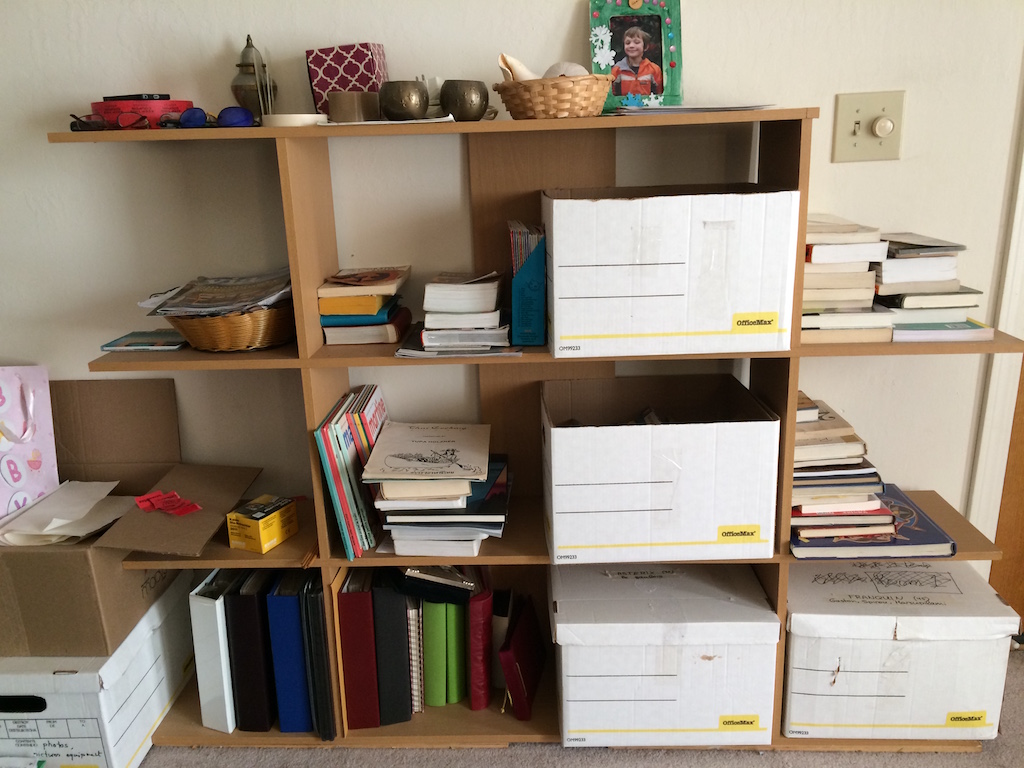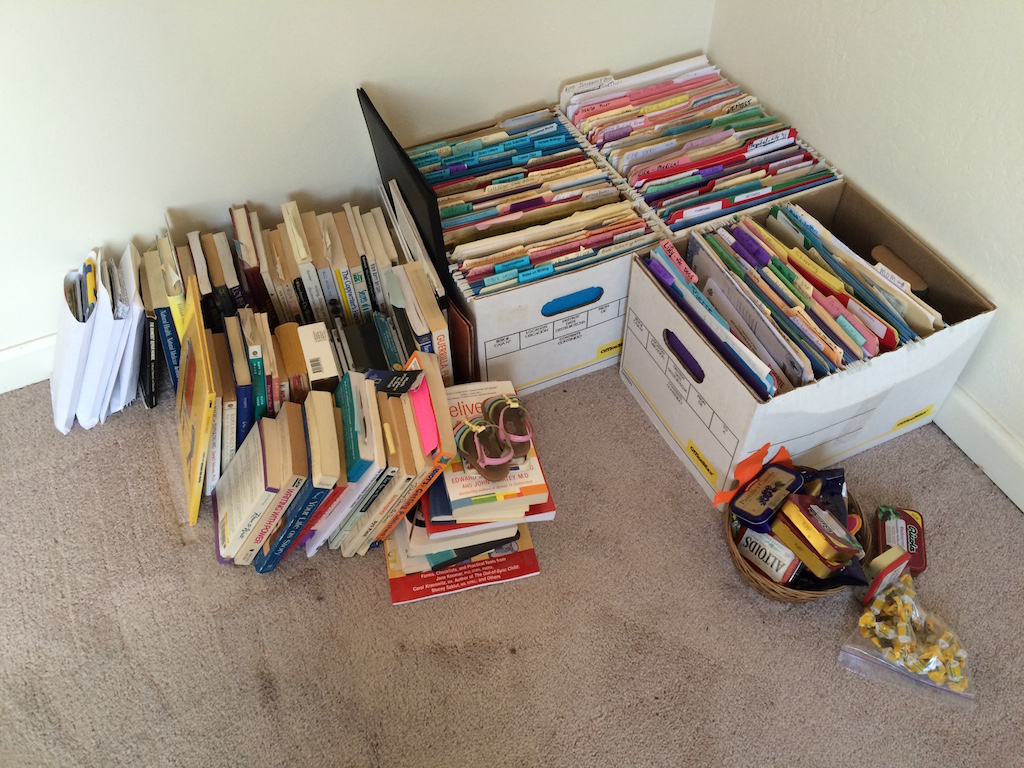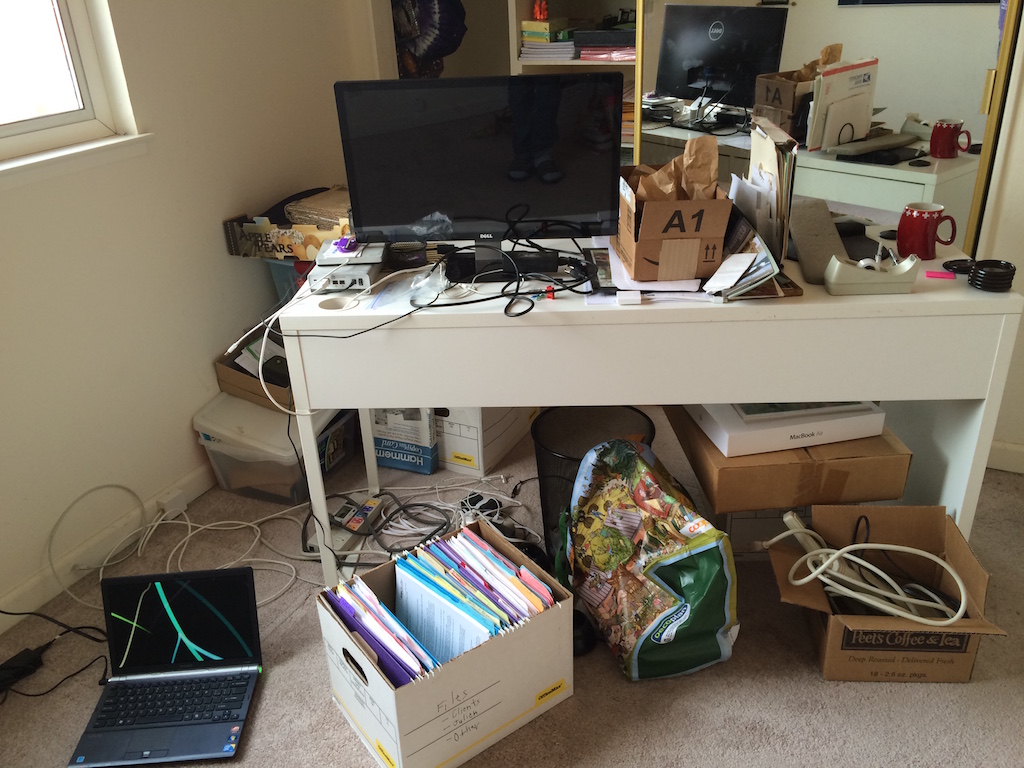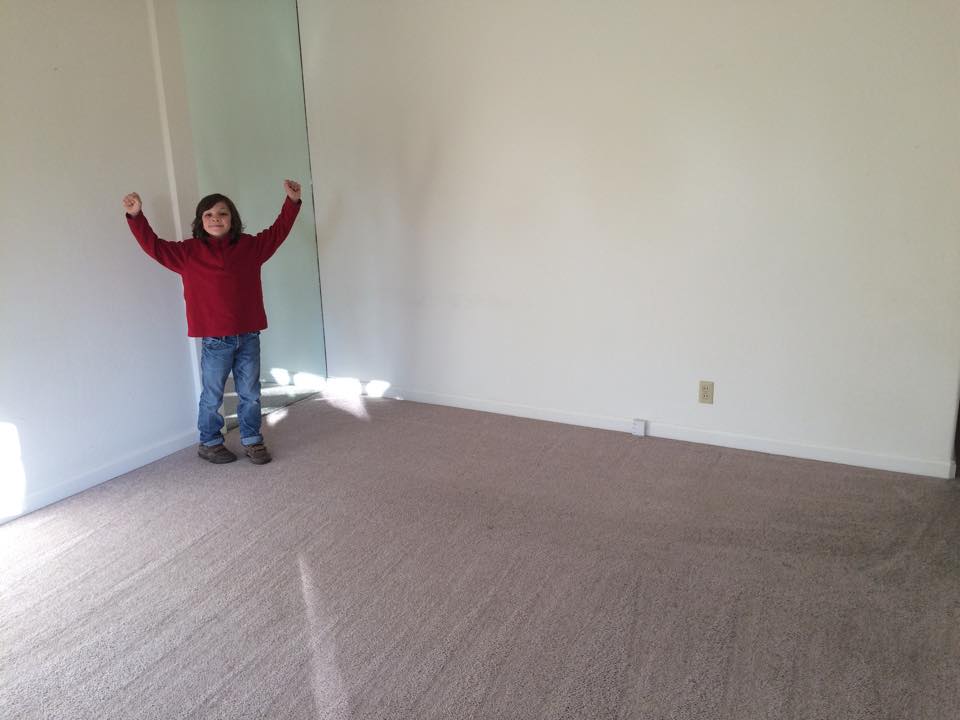 Once our family of four had made the commitment to travel the world for a couple of years, we knew what it would require: for us to get rid of almost all our belongings.
Once our family of four had made the commitment to travel the world for a couple of years, we knew what it would require: for us to get rid of almost all our belongings.
I was at first unfazed by the prospect of emptying our full, four-bedroom home in Silicon Valley, California. In fact, I was thrilled that we would be shaking off the burden of our weight. Finally, we would be light! We would be free!
I felt this way, of course, until we actually started emptying the house.
Turns out our stuff, every last piece of it, including the ugly, plastic Halloween decorations I kept for the kids, has been uniquely curated over our lifetimes—from our becoming adults through 12 years of marriage and two kids—into a kind of history of our existence. Every item had a memory or story, sometimes meaningless and forgotten, other times very much relevant and alive.
I came to realize as we were going through this process, that we weren’t just dismantling our house, we were in fact dismantling our lives. Although that was the point, I wasn’t as mentally prepared for it as I thought.
Our Goal
From the start, we set out to be pure: to get rid of all our possessions except the ones we would carry on our backs around the world. But then there were my mother’s paintings, a few souvenirs from previous travels, photo albums with the kids that took painstaking time to pull together, and a few child-created masterpieces that could not be scanned. So, in the end, we secured a tiny, closet-sized storage and vowed not to go beyond its borders. My husband smartly drew a scaled version of the closet, mathematically finding a way to maximize its space, because of course, we would fill it up.
Luckily, we were renting our home, so we didn’t have to deal with selling the house itself, just everything in it. And our house was full! Each of our two children had a bedroom of toys, games, books, clothes, furniture. We had both a family room and living room with couches, televisions, coffee tables, and crowded bookshelves. My home office had computers, printers, boxes filled with paperwork, bulging binders, more bookshelves, and six large file drawers, stuffed tight. Our kitchen was stocked with all the modern amenities, and we had patio furniture and large, plastic toys outside. In the garage, we stored an assortment of outdoor adventure gear, the usual boxes of holiday decorations, handyman equipment, boxes of clothes the kids would grow into later; and just. A lot. Of stuff.
Where do we even start?
Our Deadline
First, we set a deadline for our travels: the end of December, 2014. We then waited until after making our intentions public to friends and co-workers (and thereby, making it real to us) before doing anything. This happened in August 2014, four months before we would leave the country.
In retrospect, we should have started at least six months before, because there is a lot to do when you’re shutting down your life and emptying your house.
So how, in the end, did we do it?
Step 1: We Stopped Buying New Things
The first step we took was to stop buying anything new, and surprisingly that took some discipline.
As Americans, we’re well-trained consumers, and the buying habit, especially the impulsive kind, is hard to break. Walking in to Target to buy our son Julien a new pair of shoes, I passed the girls department and instantly convinced myself our daughter Lily needed a pack of “Frozen” themed underwear. Then I got trapped in the sports department, goggling the wide variety of plastic water bottles, wondering if we could use another one for our trip.
Rolf Potts, author of the book, Vagabonding, admits that simplifying your life for long-term travel “will require a somewhat difficult consumer withdrawal period.”
You just have to say no, no, no.
Step 2: We Made a Sales List and Sent It Out
In late August, 2014, after going public with our intentions, we made a list of all items we thought would sell for more than $100. We took pictures of these and posted them on a private web page in two lists: items that could go right away, such as coffee tables and the artificial Christmas tree, and items that you could buy but had to wait until November to pick up, such as our beds and (I’ll admit this) our 60-inch TV. This list consisted mostly of furniture, but also kitchen appliances, paintings, outdoor equipment, and one of our cars.
First we sent this link to friends and colleagues and gave them two weeks to buy items before sending the link on to various online communities to which I belonged: my huge mother’s group and a couple of women business networking groups. After another couple of weeks we posted whatever was left on Craigslist.
We sold a lot of items this way. However, they were just the outer layers; we could let them go. After this, we had to go deeper, to items to which we felt more attached.
Step 3: With Pain, We Kept Selling and Giving Away the Rest
While selling objects off our web page, we emptied furniture (whatever was in the armoire, closets, drawers) and either saved items for one huge weekend garage sale we planned, gave them to friends, or donated them to charity.
That’s when things started to get rough, as I began to labor over, for example, cherished pieces of clothing, taking days instead of hours to go through my closet.
At one point I became convinced we would never empty the house. The more we sold or gave away, the more we seemed to have left to deal with. It was like peeling the outer layers of an onion just to find: we have so many more layers inside! We sold the armoire, but all its innards were laid out in boxes across the floor, bare for us to see. It was an onslaught, an insult. How did we even come to accumulate this much stuff?
As we peeled through the outer layers—getting rid of the big furniture pieces, the books and toys, the kitchen appliances—we got deeper and deeper until we reached those core items to which we were most attached. The physically smaller items that weighed large on our psyches. The ones that challenged us!
For me, those items included my core books (A Moveable Feast, On the Road, The Magic of Thinking Big, and many others); my work files; my inline skates; my beautiful, big, white executive desk, over which I almost cried when its buyer, a fresh out of college new Google employee, dismantled it and carried it out of our house in pieces.
Items that caused Pierre to pause included all his kitchen gear, which he had carefully accumulated over his lifetime, his extensive toolkit in the garage, the rock-climbing gear, and his massive collection of Asterix comic books. (This last item, we ended up slipping into storage.)

Here’s the thing. How could it have been so hard to let go of some of these things when we had never even looked at them, much less touched them for years? Because at some point, over some period of time, they touched us, and in those moments, we established an emotional connection to those objects. They became a part of our history.
For other items, we feared we would not be able to recoup the loss in the future, that the item would be gone forever, and that felt to us profound, like we were cutting a piece of our life away. And in a way, we were.
We were selling our skis for cheap to our friends. They were going to a good home, but I really wanted, unreasonably, to find a spot in storage for them. I love to ski, and I equated giving up those skis with giving up the sport, which is not the truth, but it felt like it.
I especially wanted to keep Lily’s little pink skis, which I had purchased at a consignment store in Tahoe City and used only just the previous season, when she was two years old. She was learning to ski on those!
Obviously, we still had lessons to learn about letting go.
Step 4: Yep, the Kids’ Toys Too
Of course it was easier for me to go through our children’s stuff than it was my own. I wasn’t attached to any of that.
But my kids were. How did they handle letting go of all their possessions?
For some items, they didn’t even know they were gone. I just popped them into sell or give away boxes while they were at school. Sneaky, I know. But they didn’t miss what they didn’t even remember they had.
For the rest, we first spoke with our kids about what we were doing. Our son Julien, the nine-year-old was OK about it. Our daughter Lily, the three-year-old, less so, but she followed her brother’s lead. It helped for them to see that we were doing the same with our own things, that slowly, furniture in the house was disappearing. Strangers appeared at the door, gave us money, and took things away. Obviously, something big was happening, and the kids mostly rolled with it.
I had each child choose two stuffed animals (one to guard the storage, as Pierre had told them, and one for our travels), and two major toys to keep. Julien chose his Pokemon cards and legos, Lily her Barbies and two princess outfits. In fact, we kept a few extra toys in storage for the camping portion of our travels, after which we gave those away too.
We also let the kids choose which special toys would go to which friends, before selling or donating the rest. We also let them keep some toys, like bikes and tea sets, up to the very end, as it wouldn’t be worth selling anyway. Better for the kids to enjoy!
Step 5: We Had One Huge Garage Sale
We had one weekend garage sale in late September while we knew the weather would still be good, and it was a zoo. Our driveway and lawn were full of clothes, appliances, furniture, sports equipment, bags, games, toys, sheets, towels, everything!
We hadn’t even half-way finished going through our stuff, but we couldn’t wait longer to have the garage sale, so during it, we were still running into the house to pull out more clothes or kitchenware and bring them outside. We even had people coming into our house to look at things, such as furniture and paintings.
Everything had to go, so we were selling all for cheap. Wool sweaters and full suits for $1 each, all other clothes for 50-cents a piece. Furniture for $5 or maybe $10. We had sold our bed with its cherry wood frame, box spring, and mattress for $50 and our almost new 60-inch television for $500 (with a buyer that agreed to come get it in November).
By the end of the weekend, we had made about $2,000 from the garage sale, and about $5,400 total from all our sales efforts, which was not bad unless we thought about how much our items were really worth, if we had to buy them back. But we accepted that we had gotten a lot of benefit from those things, we had lived our lives with them, had experiences through them, gotten comfort and pleasure from them, and in that way, they had paid for themselves.

We were now ready to let them go so that we could make room for something bigger and better. We thought, if we ever want anything back again, we could always find a way to buy it. Sure, it would cost us ten times more, but, unlike time, it was replaceable.
What we didn’t sell, we donated. A lot of moms came to pick up children’s items, and we brought countless boxes to Goodwill, between five and ten boxes every weekend. Garage sales are too much work to do more than once, Pierre and I agreed. It’s more cost effective to donate the items for tax write-offs.
Step 6: We Kept Selling and Giving Away Items
After the garage sale, we were far from finished. Although now we were eating off the coffee table and moved our second couch into the living room to replace the one we had sold and had our son Julien sleep on the floor, as he had lost his bunk bed, there were still massive boxes of stuff to go through.
Up until three days before we had to be out of the house we still had furniture and loose items in it. A coworker of Pierre’s who had lost everything in a fire stopped by and Pierre gave him armfuls of his clothes, our second flat screen TV, a table, and a couch. We gave away our daughter Lily’s bed to our nanny’s son. Whatever was left by then, we placed out on the sidewalk and someone would come by and pick it up by end of day.
Step 7: We Digitized As Much As Possible
Pierre and I both had monsters to deal with. Pierre’s was the garage, and mine was my office. I had six huge, deep file drawers that were full, along with binders of my work. Somehow, they all had to go.
I went through every folder, every scrap of paper. A lot got trashed or shredded, but a lot I needed (or wanted) to keep. We also had boxes of photos I couldn’t bear to toss. What to do? I scanned it all in. It took many weeks and I broke two scanners in the process, but it got done.
My scanning showed me how attached I was to my work. I refused to let some of it go. I scanned in work papers and letters, medical records, the kids’ school records, receipts associated with taxes, most of the kids’ schoolwork and art (we saved a few choice pieces in storage). I even scanned in hand-written notes that I knew I wouldn’t have time to type up.
For my favorite books, I ensured I could find digital copies of them online and thereby have access to them whenever I wanted, and then I let them go.
Step 8: We Just Kept Moving Forward
During this time, Pierre worked full time up until 10 days before we left, and I continued to work part-time or conduct research on our trip plus manage the kids after school. In December, our final month, we had a party for Julien’s birthday and I put up my desk-sized artificial Christmas tree in an empty family room. The kids just rolled with it all, happy Santa found gifts that were allowed on our trip! We also managed to make it out for drinks and dinners and playdates with various friends to say good-bye.

During the last week, we barely slept at all. On the morning that we needed to hand our home back to the landlord, Pierre was still going through items in the garage while the carpet cleaner worked inside.
I thought it was a miracle that we made it on the plane on Dec. 28, but we did! With four stuffed suitcases and four carry-on backpacks and one “electronics” bag. We had done it.
Lessons Learned
Here is the truly amazing result of this massive downsizing exercise: we don’t miss a thing. Nothing. The kids don’t even miss their toys, not a single one of them. They miss their friends, of course, but they don’t miss their stuff. Last night they played for an hour with a couple of straws, a chopstick, and each other. This was eye-opening!
Another lesson that should not have been a surprise: the act of downsizing gets easier each time you do it. When we left Switzerland in winter to head to Spain in spring, we left behind an entire suitcase of cold-weather clothes, donating them through our in-laws to African refugees. I was only slightly hesitant to give up my long, leather black boots and a lambs wool sweater I had purchased in Florence, Italy, but still, it was far easier this time to let go.
When we finished camping our way through national parks in the U.S., we gave up another set of items: all our camping gear, more toys, more clothes, and our dependable, lovable SUV, which incidentally also went to a good home, as one of our friends bought that from us. And it was even easier.
“There is a being in you, an existence of you, that is separate from your possessions and your routines,” writes Rolf Potts in his book, Vagabonding. By letting go of your possessions, that being has more space to come alive, to “be.” We feel that.
It’s true what they say: only by letting go of the old can we make room for the new. We have made room and had our spirits, hearts, and lives generously filled with the experiences of our travels in the last year. We hope to remain this light, and this free, as we continue our journey into the future.
This blog post, including photos, is copyrighted (c) 2016 by Cindy Bailey and is an original publication of www.mylittlevagabonds.com. Please join us on Twitter and Facebook. Happy travels!
Truly epic! I’ve been slowly de-cluttering in anticipation of something similar but man, the books are gonna be hard to let go of.
I know, huh? It’s not easy. For my favorite books, I made a list of them, and then looked each one of them up to ensure it had a digital copy out there in cyberspace, which I could access at any time. Only then, could I let them go. …So now, you have to tell me what you mean by “something similar.” 🙂
Hah! Well, we’re trying to strategically exit the completely bonkers Bay Area sometime in the next two years, which will coincide with my 45th birthday. Feels like the right time, and I’m hoping I can just continue to work as we go. I’d love to squeeze some RTW travel in between this life in SF and our next life in a TBD place… We just gotta put that date on the calendar 😉
Putting the date on the calendar is the hardest part! Everything finds a way to fall into place after that. But change, as you know, is exciting! Let me know how it goes, and where you guys end up.
I’ve read so much about simplifying, decluttering or minimalism, but you don’t always get the emotional stories or challenges as you go through it. I love the unfolding as you describe the process of getting rid of your possessions. Step 1 is so important. The conclusion is priceless. Love your article.
We have no intention of moving or vagabonding. But we do our best at decluttering and instead surround ourselves with what we love and bring us joy (think Mari Kondo). It’s not easy and a work-in-progress. Sometimes, I dream of starting from a blank canvas and only deal with making new choices, instead of facing the old choices I made.
So beautifully said, Madeline, thank you! Change, I think, is rarely easy, but the rewards are often great. I love that you take such a conscious, mindful approach to de-cluttering. That’s where the meaning lies. Hope you guys are well! Take care!
I bow to the physical and emotional work you guys did to be able to travel lightly on the planet, very impressive! We just moved (again) and I always declutter and get rid of things, but never to the extent you did. I am in awe!
Thank you, Heidi! Regular pruning is good, too!
Wow, this article was truly inspiring. It really read like a page turner. While I know how important it is to lighten our loads, it can be very difficult. I’m impressed beyond all belief, and I know that what you did will serve you well. I will definitely use you as a role model 🙂
Thanks so much, Betty!
Ah Cindy I so admire you and your honesty with this whole process! It’s been over two years now… Have you settled back in America? Do you miss your stuff now? I would love to get rid of all the stuff my family and I have and just have the bear essentials but what stops me is fear of regret and like you said that emotional attachment to material items what a trap it is! Would love to just walk in my house and breathe without seeing any clutter!
Hi, Emily – Thanks! De-cluttering can definitely be an emotional process. For me, it helped that we were leaving our environment to go travel the world and distract ourselves with new adventures. We didn’t miss a thing, and we still don’t! We are back in California for the time being and had to get some things again, such as furniture, more clothes, kitchenware, etc., but we are still living with mostly only what we need and that feels really good! We don’t allow ourselves to accumulate and we also avoid buying anything new, getting most things from friends, give-aways, or thrift shops. I understand that fear of regret to let anything go. What we told ourselves is that we could always re-acquire items if we really wanted them back, but we couldn’t re-acquire time, so we let things go. We did put sentimental items in a small storage. So if you’re too emotionally attached to something, keep it! But if it’s weighing on you, letting go feels good. Hope that helps! Thanks for reading. Cindy